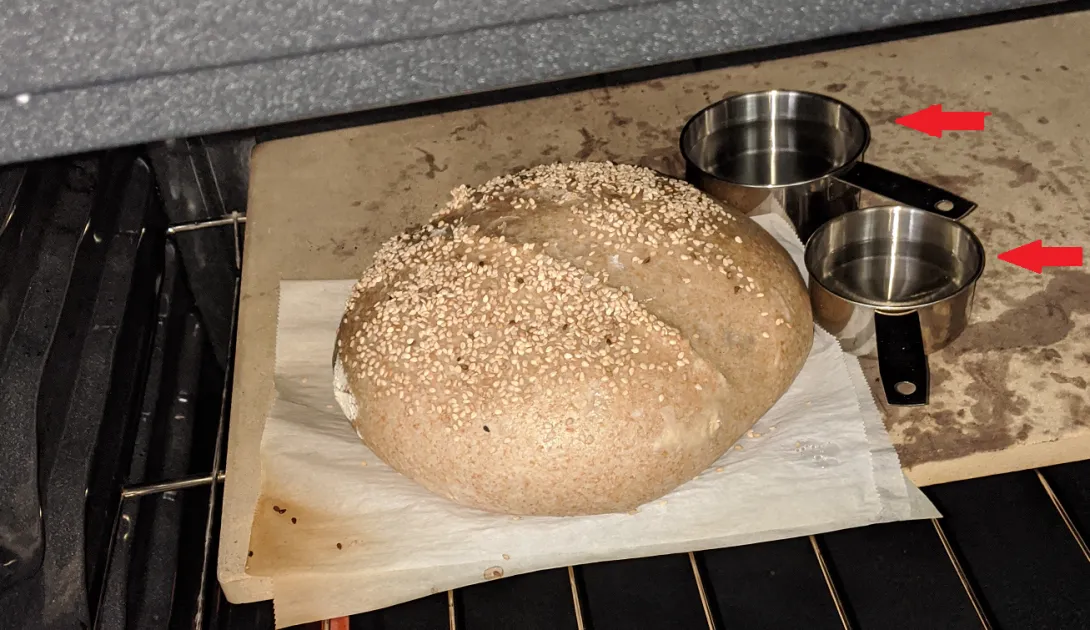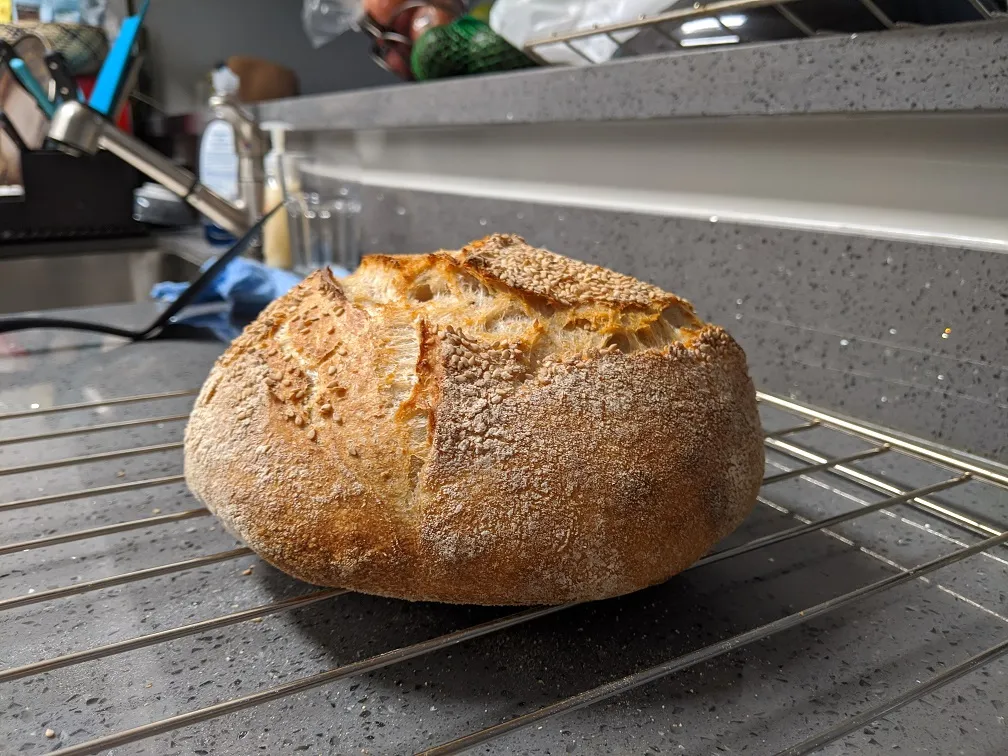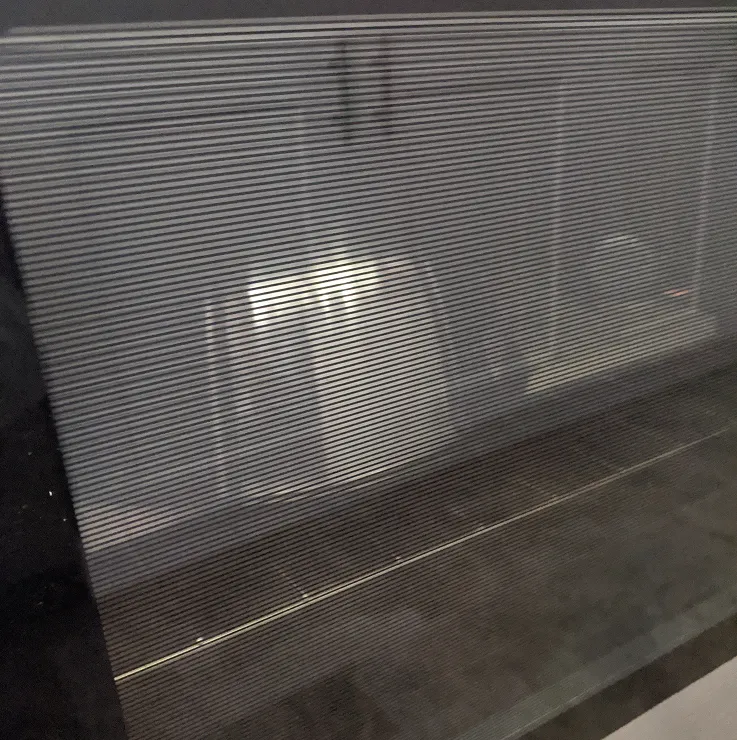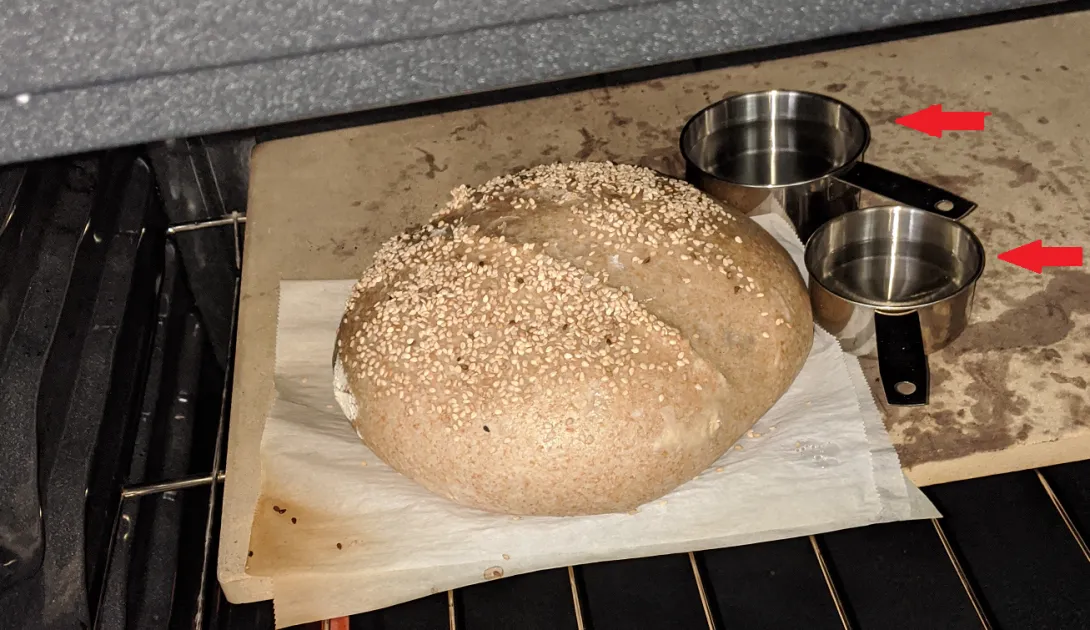
Hello,
Long time reader, first time poster.
I am trying to improve my sourdough oven spring. I normally do it in the dutch oven, and it is alright, but not spectacular.
Here is how it looked yesterday from the dutch oven. The crumb was nice and opened too .

It is 75% hydration, 10% whole wheat (Tartine inspired country loaf with lamination added instead of first fold).
Now i am trying to improve on this, because my dutch oven is kind of smallish, for batards etc.
So I am trying what I saw on KA https://www.kingarthurflour.com/blog/2017/02/28/steam-in-bread-baking
I think I even bought the same mixing bowl, or at least one with very similar dimensions.
After a few flat-ish brads I decided today to add as much steam as possible.
I have a gas oven, heating comes from below. There is a big vent on the top.
I have a baking stone. I did these things:
1) Loaded the scored loaf from the fridge onto the stone, and splashed (spritzed) it with water.
2) Put a few ice cubes next to it
3) Had two pre-heated measuring cups made out of stainless steel filled with almost boiling water (1 cup and 1/2 cup)
4) added a tray below and poured a bunch of boiling water
5) closed the thing with a giant mixing bowl, but with an offset so that the steam can come from below.
I baked at 500 degrees Fahrenheit (it actually dropped to about 475 or so after putting).
This is how it looked:

The picture is not great, my apologies.
So there was a few ice-cubes, a cup and half of boiling water, and a cold 700 gram loaf inside that super hot mixing bowl, plus there was water boiling from the tray below and steam hopefully entering the offset.
I baked for about 20 minutes, and started removing the mixing bowl, and the tray below.
Btw even after 20 minutes there was still water in the tray boiling away!
To my surprise this is how it looked, there was still water in those measuring cups. So even after 20 minutes under the mixing bowl in the 500 degrees oven they didn't evaporate somehow. I do not understand that.
How is it possible that the water still exists in those measuring cups?
How is it possible that the bread didn't open up more, to be at least on par with the one from the dutch oven?
Is my problem not enough steam here?
Should I try to make the offset tinier?
Or is my mixing bowl too tall and the steam is not on the loaf?
Any suggestions on what could I improve>
Thank you in advance for your help.
It's possible that the baking tray you were using for steaming simply isn't conductive enough to rapidly produce enough steam necessary for oven spring. What I do and what I've seen a lot of others do is get a cast iron skillet and fill it up with lava rocks, old nuts/bolts/screws, a long length of chain, etc. and preheat that. Cast iron has a very high heat capacity and filling it up with more high-surface area, high heat capacity objects will ensure that the second water hits that screamingly hot skillet, it'll instantly evaporate.
Thank you for your answer.
I notice that a lot of people use lava rocks, but i thought since the ice cubes and the stainless steel measuring cups full of water are inside the same mixing bowl as the loaf, that they would evaporate and create steam.
So the stainless steam inside is not conductive enough too? That is why I had water in those cups 20 minutes in?
Keep in mind that a measuring cup has a low surface area to volume ratio so the water inside it will boil off slowly throughout the bake, but artisan loaves need steam immediately after hitting the heat. I think the problem comes less from the measuring cups and more from the steel baking tray not being hot or conductive enough. I suggest either 1. adding lava rocks or conductive items to the baking tray to more immediately produce steam or 2. don't use the baking tray at all and position the bowl so it completely covers the loaf and traps all the steam (you can keep the ice cubes and measuring cups).
Yeah that makes sense.
I guess I will try 2) first, because I don't have lava rocks on hands.
Since you are suggesting to remove the tray and position the mixing bowl to completely trap all the steam (no offset), that must mean that I loose steam through the offset?
I was under the impression that since it is hot in the oven, and steam only goes down as it cools, that it won't go down at all in my setup (and therefore no steam will be lost). I guess I was wrong.
I messed around a lot with different steaming methods and none of them did a darn thing for my bread.
I think this is why the closed pot method is so popular. It just works way better for way less fuss and mess than any other kind of steaming method except for piping wet steam into the oven.
Under the pandemic conditions, it's very difficult, but once things are back to normal, go on a scavenger hunt to all your local thrift shops. Last fall I picked up an enameled steel combi roaster (can be used upside down, with the lid on the bottom) and a German clay braising vessel. I'd really like to get a big square covered roaster that can hold several loaf pans, or a row of baguettes, but I'm not willing to pay ebay prices. Yet.
These guys sell a large oval roaster and a large round roaster for $33 each, so not as cheap as the thrift store but way less than the fancy le cruset and staub stuff. https://www.ironaccents.com/pages/search-results-page?q=farmhouse+enamelware
Bottom line, I'd focus on expanding your enclosed-vessel steaming paraphernalia rather than your full-oven steaming paraphernalia.
P.S. Also, if you spray the inside of your giant mixing bowl with water, spray your bread dough, and then place the bowl over the bread so that it is completely sealed, it will act just like a closed pot and I think you will get a much better result. You don't need the measuring cups in there.
Yeah, definitively not easy to find stuff to buy atm, but this too shall pass :)
Interestingly my bowl is actually not that much taller (if at all) than my dutch oven. Its just bigger in volume, i need to make up the difference.
Here is what I believe happened: you overloaded your oven and cooled everything off.
Heat is a resource. Water absorbs a MASSIVE amount of heat without doing much. You put so many forms of water, including ice, which is the worst as far as "stealing" heat goes, that you cooled off your oven to the extent that your all water didn't even evaporate. Way too much of a good thing.
1 ice cube inside the mixing bowl, or even just spraying the inside of the bowl with water before putting it over the loaf, is PLENTY. If you still aren't getting the ovenspring you want, then that's a shaping problem, steam won't cover every sin. :)
Hehe alright, that could be.
I kind of don't think its shaping because i get good results with the dutch oven constantly.
I am just trying to expand beyond the dutch oven in order to be able to do bigger loaves etc.
Thank you for your comment. I will try with less :)
I'm in the same boat, except I don't own a dutch oven, so I'm trying to experiment with a lot of different steaming methods. I posted my first round of (sort of) experiment using a towel and ice cubes. And my loaf came out pretty well.
http://www.thefreshloaf.com/node/64071/sameday-bake-steam-challenge
A lot of people swear by the towel method, though I haven't done it enough times to be completely confident.
Amara nailed it.I overloaded my oven. It is not powerful enough for all that water and ice.
Here is how I know.
I did an experiment today. Big batch of dough enough for two loaves.
I baked both inside the dutch oven (same dutch oven) one after another.
The only difference was I added two ice cubes with the boule (first), and nothing with the batard (second).
The difference is enormous.
Check it out
With ice:
The closest end to the ice was soft and mushy. Rise was weak. It was disappointing.
Then I did it ice-free.
Here we go.
That is the difference between no-ice and ice.
I almost can't believe how much two tiny ice cubes screw everything up.
And its a cast iron heavy Dutch Oven preheated 50 minutes on 500 degrees.
Amazing.